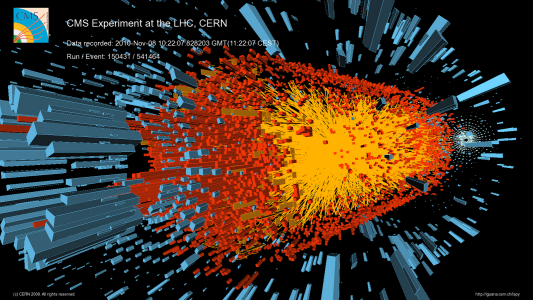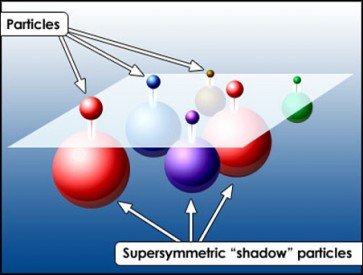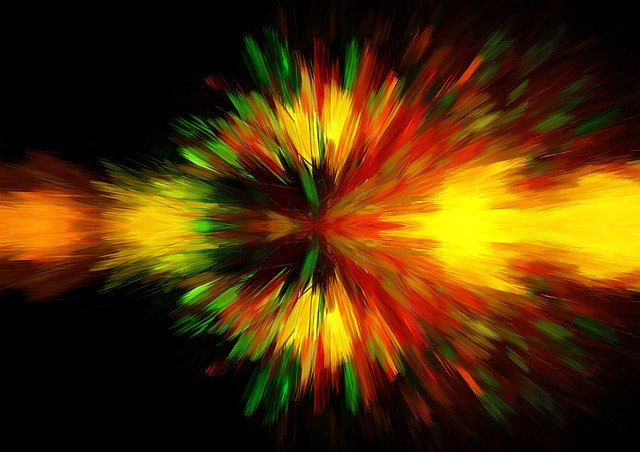About my own research: gluons, gluinos and sgluons are not weird creatures from Harry Potter
One of my favorite activities on Steem is to write about my own research work. This happens every once in a while, in particular when I release one fresh paper. The topic of the day is not an exception to this.
A few weeks ago, two of my collaborators and myself published the results of a long-standing research work addressing the implications of the LHC for a new type of particles called sgluons.

[image credits: CERN]
Those sgluon particles are not something completely crazy, popping up from nowhere. There are however several assumptions behind the prediction of their existence.
First of all, one must admit it is necessary to go beyond the Standard Model of particle physics. I will come back to this below.
Secondly, one must accept that supersymmetry is a nice idea about all the possible extensions of the Standard Model. I will also come back to this below.
Finally, as supersymmetry has not been found yet, as shown for instance here and there, supersymmetry may appear in a way that is less simple than expected. When all of this is accounted for, one ends up with non-minimal supersymmetric paradigms.
These paradigms address not only some of the problems of the Standard Model, but they also allow for evading all current constraints more easily. However, the most important point is that these non-minimal models yield new phenomena that are potentially not searched for, as not usual in more standard extensions of the Standard Model.
This was the exact point of my new research article. Some supersymmetric models are in agreement with all experimental data so far. Whilst they could be constrained or even potentially discovered with existing data, they are however not searched for in the most appropriate way.
And one must ensure that all options for new phenomena are experimentally covered to exploit the LHC as good as possible.
As usual, a stupid stuff is hidden in this post… ;)
GOING BEYOND THE STANDARD MODEL
The Standard Model is one of the most tested theory of all time. With one single theory, one covers more than 30 orders of magnitude, from the lowest experimental bound on the mass of the photon to the collision energy of the Large Hadron Collider at CERN.
After fixing a handful of parameters, one get predictions that agree with dozens of thousands of measurements undertaken during the last 60 years. Despite its success, there are however several conceptual issues with the Standard Model that make us uncomfortable.

[image credits: photovicky (CC0)]
For these reasons, physicists usually consider the Standard Model as the visible part of a more fundamental theory that needs to be discovered.
In other words, the Standard Model consists in the noticeable tip of a huge and deep iceberg, and we have no clue about details of what lies below sea level.
We however have some ideas to follow. For instance, dark matter. The Standard Model does not say anything about most mass in our universe. Many extensions of the Standard Model therefore propose a candidate particle for dark matter.
Another intriguing fact comes from the Higgs boson. Whilst it allows for generating the masses of the particles of the Standard Model, the Higgs also brings a ton of others problems. The most well-known of these is the infamous hierarchy problem that many new physics theories try to solve.
And we can add many more points on this list, like neutrino masses, the unification of the fundamental interactions, the number of families in the Standard Model, etc.
As we are theoretically in the dark, the experimental program addressing the search for new phenomena is huge, and studying theoretically as many new physics theories as possible will allow us to be sure that every option will be probed.
SUPERSYMMETRY
In nature, there are two classes of particles, namely the bosons and the fermions. Bosons and fermions differ by their spin, which consequently yields these particles to have different properties. In the Standard Model, all matter particles are fermions whilst the Higgs boson and the mediators of the fundamental interactions are bosons.
Supersymmetry consists, as its name can let us guess it, in an extra symmetry of nature that one may impose when constructing a theory for the elementary particles.

[image credits: everywhere on the web]
By definition, a supersymmetry operation changes the bosonic/fermionic nature of the particles. In other words, supersymmetry transforms a boson into a fermion, and vice versa.
In the minimal supersymmetric scenario, each Standard Model particle possesses a so-called superpartner.
We have quarks and squarks, electrons and selectrons, Higgs bosons and higgsinos, etc.
Particles connected by a supersymmetry transformation must have similar properties, like their mass, their electric charge, and so on. And here data kills us: any superpartner of the electron for instance, should have already been observed.
Supersymmetry is thus a broken symmetry, which allows for the introduction of shifts in the masses. This is not a big deal: breaking a symmetry is standard. And we get the small (the Standard Model) and big (the superpartners) spheres of the above image.
But the price to pay is that this makes a nice idea ugly… ;)
Supersymmetry has many advantages. The best ones include a solution to the hierarchy problem, an explanation for dark matter, for unification, etc.
SGLUONS, GLUONS AND GLUINOS
While supersymmetry may sound cool, there is not a single hint for supersymmetry in data. Equivalently, the preferred most minimal supersymmetric model is more and more constrained, and can only barely accommodate all data. If the simplest option fails, then one could try the next-to-simplest one.

[image credits: Pixabay (CC0)]
One of the feature of the simplest superymmetric model is that the supersymmetric partner of the gluon, called the gluino, is a fermion that is its own antiparticle.
There is however no such fermions in the Standard Model, so that one may be tented to remove them.
Gluinos can have a different antiparticle, but there is a price to pay: one must add extra particles named sgluons, or scalar gluons, to the theory. Those are like gluons, but without any spin. We have two of these guys and they are technically called a scalar and a pseudoscalar sgluon (let us skip any detail here).
The scalar couples to all quarks and gluons of the Standard Model, and it is actually constrained to be very heavy. The pseudoscalar has the property to only interact with the top quark. As a result, it automatically evades all constraints stemming from current searches, as the latter assume a coupling to all quarks, to gluons, or to both.
The pseudoscalar sgluon is therefore allowed to be light, which can also be easily cooked theoretically, in contrast to the scalar guy.
CONSTRAINING PSEUDOSCALAR SGLUONS
Pseudoscalar sgluons have a specific signature made of four top quarks. The good news is that the CMS collaboration of the LHC has measured for the first time the rate associated with four-top production. Consequently, we have a handle on those pseudoscalar sgluons.
With my collaborators, we have reimplemented this CMS analysis in the MadAnalysis 5 framework, which is exactly the project I am currently running within @utopian-io (see here for the last episode and there for the main idea).

[image credits: Inspire]
Our results are shown on the so-called Brazilian plot on the right.
In grey, we have the theoretical predictions for sgluon-induced four-top production, given as a function of the mass of the sgluon
In yellow-green (the Brazilian flag), we have the rate that are maximally allowed by data for each sgluon mass.
In the region where the grey band is above the Brazilian band, we predict too many sgluons to be compatible with the non-observation of any signal. The corresponding mass hypothesis is therefore excluded.
In the region where the grey band is below the Brazilian band, sgluon-induced four-top production is small enough to be acceptable.
We have hence imposed the first constraints on pseudoscalar sgluons, that must be thus be heavier than 1 TeV (roughy 5 times the mass of the heaviest Standard Model particle).
SUMMARY
In this article, I discussed the motivation behind going beyond the Standard Model of particle physics and focused on one specific class of scenarios dubbed supersymmetry. The supersymmetric framework is extremely well motivated, but it however suffers from one important thing: no supersymmetric particle has been discovered so far.
For this reason, nature could be supersymmetric, but in fact not minimally-supersymmetric. I detailed one of my recent research work along these lines, where non-minimal supersymmetry may predict signals that are not covered by LHC searches.
One of these signals concerns pseudoscalar gluons, that were in fact only barely constrained so far. A recent CMS measurement has however changed the picture dramatically, and severe constraints now exist. In our research work,. we have quantitatively evaluated those constraints.
For the fun, we have also proposed modifications of the existing searches to make them much more efficient in probing sgluons. I hope the experimentalists will buy the idea!
STEEMSTEM
SteemSTEM is a community-driven project that now runs on Steem for more than 1.5 year. We seek to build a community of science lovers and to make the Steem blockchain a better place for Science Technology Engineering and Mathematics (STEM).
More information can be found on the @steemstem blog, on our discord server and in our last project report. Please also have a look on this post for what concerns the building of our community.
I read recently that some new linear colliders are to be built. The energy of the collision would be less energetic (a few TeVs), but the configuration of the machine would allow somehow a better focus on the collision characteristics themselves, and consequently observe particles of higher mass than those detectable at the LHC.
You mention a lower limit for the mass of the sgluon of around 1 TeV/c2. Do you think that the energy range of these new linear colliders would be sufficient to detect the sgluon?
Yes, @LeMouth, my students are finally one after the other going on summer break, leaving me some time I can dedicate for writing / reading some Steemit STEM posts :-). I decided to come back with a bang: episode 4C of the particle Physics series (CPT cymmetry :-)! ). I hope you enjoy it!
May be built is the right word. Particle physicists are discussing (for many years already) the building of an International Linear Collider (colliding electrons and positrons). For now, the most probable option would be a 500 GeV machine (that could be upgraded to 1 TeV), and Japan would host such a machine. There is however no final decision yet, as it has to be taken later this year.
No. Because you can't produce them from an electron-positron initial state. You would need to produce them in association with a top-antitop pair, and the resulting rate is negligible (assuming you have enough energy at all).
I haven't read it yet. I am about to board to Namibia to contribute to the development of particle physics in Africa. I promised several stemng people to write about it, but I didn't find the time yet :/
As I said in the other post, I am happy to see you are back! :)
Actually, i digged back where I read this about the linear colliders. Yes, these are just on the drawing board. I had more "clicked" on the other one, the CLIC (pun intended ;-), not the one in Japan. It would propose electron-positron collisions around 3TeV.
Within the arguments they are putting forward for its construction, is the study of some Top Quark physics
(https://en.wikipedia.org/wiki/Compact_Linear_Collider). With some luck, maybe some s-gluons showing up in a few decades ? :-)
That is so cool! I look forward to reading the story of your adventures over there!
The CLIC project is not really discussed today. There are physicists still studying what we could do there, but the the really serious options are the ILC (linear electron-positron machine) or the FCC (circular machine in which one could possibly collide electrons and positrons, protons, or electrons-protons).
I should write what I do here... but the arrow of time is killing me ;)
I hope you really enjoyed your time promoting P. Physics in Africa. I am curious to know how your audience reacted. I am considering introducing the subject to the high school students in Nigeria once we have covered enough ground in the basics of Physics, probably mid next scholar year.
I find that Particle Physics is something that can get someone really fascinated, maybe addicted, and that, even for people that do not really enjoy general physics as a topic... :-)
The theory lectures were very hard, especially because the level of the students was extremely spread. They ask an incredible number of questions, which was amazing too me. They are by far not shy.
The best was we organized a tutorial session where all the students managed to simulate LHC collisions. They didn't want to leave the room, even those not related to particle physics :)
Yes, it is quite amazing, the willing to learn of these young girls and guys! I can compare this to my own students here. I remind them sometimes the luck they have to have all this knowledge offered to them on a silver plate.
In terms of spread, I agree too. The class in Nigeria is really spread out in terms of age group (13-17, learning the same things). I also found interesting that the brightest students are often quite young, but that's probably a faulty correlation due to the small sample...
I am glad you had such a great time!
Yes, we must be careful with statistics. Especially in such a school where the selection has been made including many diversity criteria (sometimes predominant).
Going to sound really dumb because I'm no physics expert, but could these observations be larger than expected because of their symmetric counterparts, but those counterparts are hard or impossible to observe if what constitutes gravity can only be detected by having something that can detect backwards in time, which is probably impossible with technology in a universe that goes forward in time?
I will try to answer (as I am not sure to have understood 100% of the question).
The Standard Model predicts the production of four top quarks with some rate, and any collision featuring 4 top quarks have specific properties. Now, some theories extending the Standard Model may include extra contributions to the four-top production rate. It can also screw up the properties of the 4-top collision event.
For the moment, CMS has only measured the production rate of four top quarks. This is hard to measure, because the final state is very busy (once the 4 top quarks have decayed) and that the rate is small (so that one needs to wait long before getting enough statistics). As a result, the error bars are still large, so that there is room for new physics.
However, this being said, this room is not infinite and this is how one gets limits. When the grey band is above the Brazilian band in the last figure, the sgluon contribution is much larger than the room we have. And the corresponding mass hypothesis is excluded.
Finally, gravity does not play any role here. It is negligible. The three other interactions are however important (with the strong force being the most important one).
Does it answer? If not, please come back to me!
I guess gravity really must be negligible otherwise nuclear things wouldn't be so high energy...
The mass hypothesis that's less than the observed mass makes sense.
I guess I was just guessing as to why the observed was higher than the previously calculated or imagined numbers, which must be the strong forces you're talking about.
What is a supersymmetric particle? And how different is it from other particles? Are they elements with a unique biosonic nature?
I’m just trying to understand I’m not a physics inclined person
Supersymmetric particles are just other particles that are connected somehow to the known particle. They are different in the sense they have a different mass and a different spin from their partners. A good reading on supersymmetry can be found in this old post of mine.
Gravity starts to be important at energy scales billions of billions of time higher than at the LHC. Therefore, we still have a long way to go to get there (I am not even sure this will be ever manageable). This being said, researchers are already trying to build theories that would work at these scales (quantum gravity for instance).
I am not sure to have understood the last part of your comment. Sorry ;)
So we'd need some sort of galaxy-sized ultra large collider? Heh.
Oh, I don't understand any of it either, I guess I was just saying that it must be some other forces that are causing the numbers discrepancies between real and expected values.
Something like that :D
Well not necessarily. First, this could just be statistics. Then, it could be other particles not related to new forces, and so on. There are many possible reasons behind some apparent excess or deficit. A human error being one of them ;)
its just gravity is weak compared to whatever makes particles stick together (in short as i came to understand it) so they don't really study it as such at quantum level, its more like a cosmology / astrophysics thing (dont bash me on semantics, im a very un-educated person :))
No, at least based on my limited understanding I think you are correct in what you've said.
o dear

beware my exploding ego now :p
True!
Gravity is both negligible at the level of the elementary particles and does not work at the quantum level. But since any effect would be invisible, it is fine :)
is gravity actually 'known' ? i mean not like defined like time , but is it understood like do you know what causes it , where it originates from ?
My only question: How do you pronounce "sgluon" without sounding drunk?
Lol. There is no way out: there is a price to pay when working on crazy beasts! :)
"Sgluon" gives you a tast of what it's like being a microbiologist: Bdellovibrio, Erysipelothrix, and Corynebacterium come to mind.
Made me laugh. Particularly because I also noticed its ubiquity while looking for source images for the banner in my recent post.
Sgluons is easier than this bdellothing for sure :)
These very well known images are so every where, that no one actually knows which one was the first and if was copyrighted. This makes me feeling slightly uncomfortable, but... what to do...
You can always throw a few imaginary internet dollars to @davinci.art to get one into the public domain. :)
I never think about them. I should! Maybe for the next time I will present my own research ^^
And especially the new LHC, right? I mean, to the extent that some observations will require new stuff to be built.
This is definitely a weird world and I worry that we're making much of this stuff up, and 'cooking' as you say. But if it works, it works, and that's what we care about.
😎
The Standard Model itself would require the next machine. There are a few parameters of the theory for which we have predictions and that cannot be really probed at the LHC. On the other hand, we don't know what lies a a higher scale, and exploration is in order.
From there, we may need to convince politics to fund the field. This may be tough... :(
Particle physics is definitely a weird world of its own- I'm happy to stick with my rocks for now. :)
I'd never heard of the heirarchy problem before this, at least by name. I was aware of the discrepancy in strength between the weak force and gravity, but the importance of the discrepancy and the sheer number of explanations (including supersymmetry) really surprised me.
You have a hierarchy as soon as two different scales are into the game. And when quantum corrections are in order, integrals over all scales have to been evaluated, and from there you probably can guess where one hits a rock (I am very proud of this stupid joke ;) ).
You should be, bad jokes and rock puns are the highest skill in geology!
Bad jokes consist in a universal science thing, I guess ;)
Sounds really exciting research.
No doubt I will have to re-read, re-re-read and re-re-re-read this post to grasp most of the concepts here, along with the links you kindly added to the text.
It's nice to put some context on the utopian-io project.
Can't wait to learn more!
As I said to @qiyi, some of the concepts there are complicated, and the post was already very long. Therefore, I made the choice of using big words but not giving many explanations where not necessary. Please do not hesitate to come back to me if you have any question.
At the end of the utopian-io project, we will all make nice Brazilian plots ;)
I'm just knowing that fermions can be transformed to bosons and vice verse. But I want to ask; does this have anything to do with chirality?
Hope I'm not asking a stupid question?
It has somehow a connection. In fact, we have one superpartner for each chirality. For instance, a top quark has two chiralities: left and right. Consequently, we have two superpartners for the top quark: the left-handed top squark and the right-handed top squark.
Thanks for the response sir. It is appreciated
My pleasure!
Hi @lemouth!
Your post was upvoted by utopian.io in cooperation with steemstem - supporting knowledge, innovation and technological advancement on the Steem Blockchain.
Contribute to Open Source with utopian.io
Learn how to contribute on our website and join the new open source economy.
Want to chat? Join the Utopian Community on Discord https://discord.gg/h52nFrV
I love the title! ;)
Thanks. I am not that great in finding good title... Actually, this is always the most painful part when writing a post :)
Glad everything seems to be working with your account! :)
If there is anything that deserves some myspace link, I think the hypothetical particles, superpartners, deserves that :)
Totally correct. I have never dared to listen to their music :)
Me neither :)